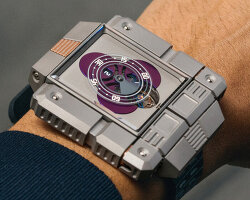less dragging with Stanford exoskeleton combat boots
People who might have problems with their motor, feet, and/or ankle; find it difficult to walk at a normal pace; or probably just do not have spare time to exert any effort walking, then Stanford University researchers – comprising Steve Collins, Patrick Slade, Mykel J. Kochenderfer, Scott L. Delp – have developed ‘exoskeleton’ combat slash robotic boots that help people walk faster with reduced effort. With this shoe design, no need to drag the body weight with the feet. The mechanism created by the researchers adds nudges people’s steps that help them power walk. Stanford’s exoskeleton combat boots have a motor that pumps the calf muscles and gives people the extra push they need to go on.
The researchers infuse this motor with a machine-learning-based model that was humanly trained over the years using emulators. The end goal of the exoskeleton combat boots is to relieve people with mobility impairments from the challenge of heavy strolling and to make them move the way they like. It sounds different from creatives who create shoes for style and fashion (just look at these orthopedic boots which are very soft, by the way). The research team hopes to improve the boots’ technology for commercialization and mass production in the coming years, so better ready the newsletter for updates when it hits the market, or pockets just in case the price goes way above expectations.

images and video courtesy of Stanford & the research team
How does it work?
Ava Lakmazaheri, a graduate student in the Biomechatronics Laboratory at Stanford University, is the one wearing the exoskeleton combat boots in the tests and video above. Aside from the slow-motion effects added to some clips, viewers can see how she picks up her speed while maintaining her posture. This is different from when people have to speed up and they just slouch or bend their bodies forward to gain speed. Wearing Stanford’s exoskeleton combat boots though comes with the price of having to adjust to it until people feel settled.
As Ava shares, the first time the wearer puts on the exoskeleton combat boots, there can be a bit of an adjustment (it really depends on the person wearing it). ‘But, honestly, within the first 15 minutes of walking, it starts to feel quite natural. Walking with the exoskeletons quite literally feels like you have an extra spring in your step. It just really makes that next step so much easier,’ she adds. The exoskeleton combat boots increase walking speed by applying torque at the ankle and replacing some of the functions of the calf muscle. So when the wearer takes a step, the robotic boots push them just before they lift their feet. It is kind of like an omen or déjà vu, but in this case, people actually feel it rather than just dream about it or see it.
The first time a person wears the exoskeleton combat boots, its system provides a different pattern of assistance each time the person walks. By measuring the resulting motion, the machine learning model determines how to better assist the person the next time they walk. It takes only about one hour of walking for the exoskeleton to customize to a new user. According to the calculations of the team, walking with exoskeleton combat boots is like walking without a 13-kilo backpack on the shoulders, and that is a lot.

the boots help people walk and run faster with reduced effort
What’s next?
Statistics buffs might get excited since the researchers say that Stanford’s exoskeleton combat boots help people walk ‘9% faster with 17% less energy expended per distance traveled, compared to walking in normal shoes. These are the largest improvements in the speed and energy of economy walking of any exoskeleton to date,’ says Steve Collins, associate professor of mechanical engineering who leads the Stanford Biomechatronics Laboratory and study. The researchers are now planning to look into their target demographics which are older adults and people who are starting to experience problems and/or difficulties with their movement.
They are also planning to design variations for the exoskeleton combat boots, so this way, they can improve balance and reduce joint pains of the wearers, depending on their needs. ‘I believe that over the next decade we’ll see these ideas of personalizing assistance and effective portable exoskeletons help many people overcome mobility challenges or maintain their ability to live active, independent, and meaningful lives,’ says Patrick Slade, who worked on the exoskeleton as a PhD student. The researchers also have high hopes that commercial partners will take interest in their technology and help their invention be developed into an actual product.

the mechanism adds nudges people’s steps that help them power walk

the motor is based on a machine-learning-based model that was humanly trained over the years using emulators

Stanford ‘exoskeleton’ combat boots

the research team hopes to improve the technology for commercialization and mass production

the boots make people walk faster up to 9%

Ava Lakmazaheri walking while wearing the untethered exoskeleton

Stanford ‘exoskeleton’ combat boots
project info:
name: Exoskeleton
team: Steve Collins, Patrick Slade, Mykel J. Kochenderfer, Scott L. Delp
institution: Stanford University













